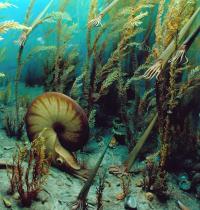Worst mass extinction shifted entire ecology of the world’s oceans
Worst mass extinction shifted entire ecology of the world’s oceans
mongabay.com
November 23, 2006
New research suggests that Earth’s greatest mass extinction did more than wipe out an estimated 95% of marine species and 70% of land species; it fundamentally changed the ecology of the world’s oceans.
The study, published in tomorrow’s issue of the journal Science, found that “ecologically simple marine communities were largely displaced by complex communities”, a shift that continues has continue since.
“It reflects the current dominance of higher-metabolism, mobile organisms (such as snails, clams and crabs) that actually go out and find their own food and the decreased diversity of older groups of low-metabolism, stationary organisms (such as lamp shells and sea lilies) that filter nutrients from the water,” according to a news release from the Field Museum, an institution involved in the research.
The study is based on the newly developed Paleobiology Database which allowed researchers from The Field Museum of Chicago and James Cook University of Queensland, Australia to track the relatively abundance of species through the Phanerozoic Eon dating from 545 million years ago until present. The research shows that before the Permian mass extinction event some 251 million years ago, both complex and simple marine ecosystems were equally common, but after the mass extinction — the cause of which is still unknown — the complex communities outnumbered the simple communities nearly three to one.
“Tracing how marine communities became more complex over hundreds of millions of years is important because it shows us that there was not an inexorable trend towards modern ecosystems,” said Peter J. Wagner, Associate Curator of Fossil Invertebrates at The Field Museum and lead author of the study. “If not for this one enormous extinction event at the end of the Permian, then marine ecosystems today might still be like they were 250 million years ago.”
Wagner said the results are relevant for today’s current extinction event.
“Studies by modern marine ecologists suggest that humans are reducing certain marine ecosystems to something reminiscent of 550 million years ago, prior to the explosion of animal diversity. The asteroid that wiped out the dinosaurs couldn’t manage that.”
“Paleontologists had long recognized that ecosystems had become more complex, from the origin of single-celled bacteria to the present day. But we had little idea of just how profoundly this one mass extinction–but not the others like it–changed the marine world,” added Scott Lidgard, Associate Curator of Fossil Invertebrates at The Field Museum.
|
Before the mass extinction and massive change
In the late Permian about 253 million years ago–just before the largest mass extinction ever–the ocean floor was profoundly different than it is today. Complex marine ecosystems and simple marine ecosystems were equally common. This photograph of a Field Museum diorama of the ocean floor before the end-Permian mass extinction shows several simple, fixed organisms, including brachiopods, corrals and large yellow sponges (on the right). New research indicates that after the mass extinction that marks the divide between the Paleozoic and Mesozoic, complex ecosystems largely displaced these simple ones. After the mass extinction and massive change
In the Cretaceous about 80 million years ago–well after the end-Permian mass extinction–the ocean floor was dominated by complex ecosystems that had largely displaced the simple ecosystems. This photograph of a Field Museum diorama of the ocean floor during the Cretaceous shows many free-swimming, complex organisms, including the large ammonoid (in the center of the image) and the long nautiloids (with handlike ends). In addition, the ocean floor is littered with mobile clams and snails. |
RELATED ARTICLES
Poisonous volcanic gas probably caused worst mass extinction says new study
The mass extinction event at the end of the Permian — where more than two-thirds of reptile and amphibian families perished and 95% of oceans life forms became extinct — was probably caused by poisonous volcanic gas, according to research published in the journal Geology. The researchers believe that volcanic gases from the eruption, near present day Siberia, depleted earth’s protective ozone layer and acidified the land and sea.
Global warming may have triggered worst mass extinction
A dramatic rise in carbon dioxide 250 million years ago may have caused global temperatures to soar and result in Earth’s greatest mass extinction, according to a study published in the September issue of Geology. Global warming, which may have produced temperatures 10 to 30 degrees Celsius higher than today, would have had a significant impact both on oceans, where about 95% of lifeforms became extinct, and on land, where almost 75% of species died out.
This article is based on a news release from the Field Museum.
















